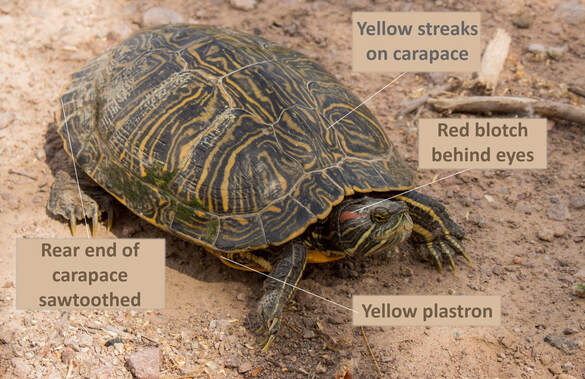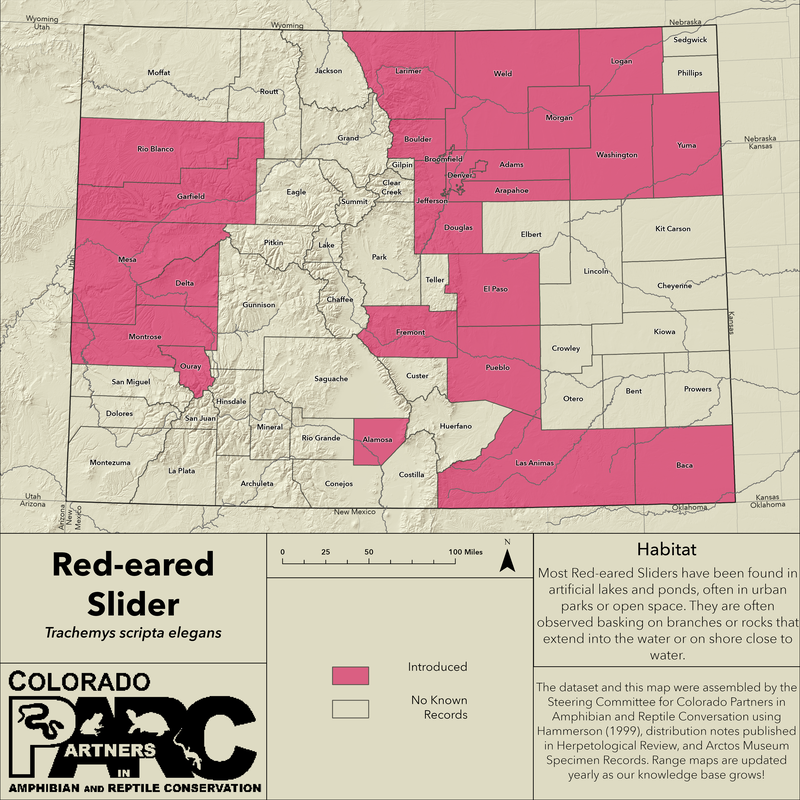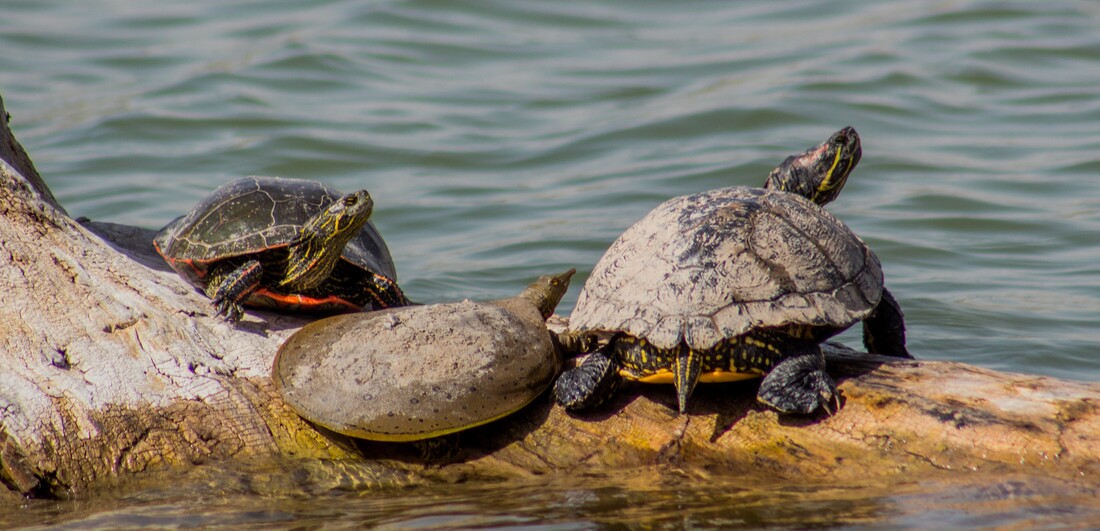Red-eared Slider
|
|
Diagnostic Features
Coloration / Markings: Compared to females, males have longer forelimb claws, thicker tails and an anal opening behind the rim of the carapace. Diagnostic coloration most vivid in small individuals, often becoming obscured in large individuals, especially males.
Size: This is a sexually dimorphic species with females often obtaining a larger adult size than males. Males reach a carapace length of up to 20 cm (7.9 inches), while females can attain a length of 28 cm (11 inches) (Ernst et al. 1994). Red-eared Sliders hatch at a carapace length of about 2.5-3.5 cm (1.0-1.4 inches) (Ernst et al. 1994).
General Distribution: Native range mostly the central and south-central portions of the Mississippi River drainage, from Illinois to the Gulf of Mexico, and from New Mexico to West Virginia (Powell et al. 2016). There are many additional disjunct localities throughout the United States, including a large number resulting from introductions. Additional introduced populations have been documented worldwide, including in the Caribbean, Central America, South America, Europe, Asia, Africa, Australia, and New Zealand.
Colorado Distribution: Most observations of Red eared Sliders in Colorado are from areas with large human populations, especially along Colorado’s Front Range and along the Platte River drainage to the northeast. Additional scattered observations have been made in west-central Colorado, Alamosa County, and Baca County. Red-eared Sliders in Colorado have been observed at elevations of 3,924 to 7,556 feet (1,196 – 2,303 m). To date, all observations are believed to be of introduced individuals (Livo et al. 2017).
|
Habitat: In Colorado, most Red-eared Sliders have been found in artificial lakes and ponds, often in urban parks or open space. They are often observed basking on branches or rocks that extend into the water or on shore close to water.
Conservation Status: Considered a non-regulated species in Colorado. Release of captive (pet) animals is believed to be the source of virtually all Red-eared Slider observations in Colorado. Do not release captive Red-eared Sliders, as they may have negative effects on native turtle species, e.g., transmission of disease and competition for basking sites. Red-eared Sliders have been listed among the ICUN’s 100 of the World’s Worst Invasive Alien Species (Lowe et al. 2004).
Activity: Red-eared Sliders are diurnal (active during the day). Basking individuals can be observed on nearly any warm day so long as ice is off the water. In Colorado basking Red-eared Sliders have been observed every month of the year, from late January through early December (Livo, personal observation). At night they sleep on the bottom of the pond or while floating at the water surface. Adults spend winter underwater.
Reproduction: Courtship takes place in the water and elsewhere has been observed both in the spring and the fall. Nesting occurs in the spring and summer, with peaks in May and June. Successful reproduction in Colorado Red-eared Sliders has not been confirmed to date. Elsewhere, females produce up to five clutches of 2-23 eggs per year (Ernst et al. 1994). In some populations hatchling overwinter in the nest, while elsewhere they emerge from nests beginning in late summer.
Feeding & Diet: Red-eared Sliders are omnivores, consuming a variety of plants, invertebrates, small vertebrates, and sometimes carrion. Juveniles tend to be more carnivorous, while adults consume more plant matter.
Defenses from Predation: When approached or touched by a potential predator, a slider will retract its head and use its limbs to tilt the carapace towards the predator. Although some Red-eared Sliders remain basking even with the nearby presence of humans, other individuals slide into the water at the first sign of disturbance.
|
Cited & Additional Resources
Ernst, C. H., J. E. Lovich, and R. W. Barbour. 1994. Turtles of the United States and Canada. Smithsonian Institution Press, Washington.
Hayes, F. E. 1989. Defensive stances in turtles. Herpetological Review 20:4-5.
Livo, L. J., C. Wild, T. L. Wilcox, B. Shipley, B. Lambert, J. Ehrenberger, T. Warfel, and J. Logan. 2017. Distribution and activity season of the introduced Red-Eared Slider (Trachemys scripta elegans) in Colorado. Herpetological Review 48:734-739.
Lowe, S. J., M. Browne, and S. Boudjelas. 2004. 100 of the World's Worst Invasive Alien Species: A selection from the Global Invasive Species Database. Published by the Invasive Species Specialist Group (ISSG) a specialist group of the Species Survival Commission (SSC) of the World Conservation Union (IUCN), Auckland, New Zealand.
Powell, R., R. Conant, and J. T. Collins. 2016. Peterson Field Guide to Reptiles and Amphibians, of Eastern and Central North America. 4th edition. Houghton Mifflin Harcourt Publishing Company, New York.
Hayes, F. E. 1989. Defensive stances in turtles. Herpetological Review 20:4-5.
Livo, L. J., C. Wild, T. L. Wilcox, B. Shipley, B. Lambert, J. Ehrenberger, T. Warfel, and J. Logan. 2017. Distribution and activity season of the introduced Red-Eared Slider (Trachemys scripta elegans) in Colorado. Herpetological Review 48:734-739.
Lowe, S. J., M. Browne, and S. Boudjelas. 2004. 100 of the World's Worst Invasive Alien Species: A selection from the Global Invasive Species Database. Published by the Invasive Species Specialist Group (ISSG) a specialist group of the Species Survival Commission (SSC) of the World Conservation Union (IUCN), Auckland, New Zealand.
Powell, R., R. Conant, and J. T. Collins. 2016. Peterson Field Guide to Reptiles and Amphibians, of Eastern and Central North America. 4th edition. Houghton Mifflin Harcourt Publishing Company, New York.
Account compiled by: Lauren Livo
Reviewed by: Brad Lambert
Last updated: 3/23/2022 by Rémi Pattyn
Reviewed by: Brad Lambert
Last updated: 3/23/2022 by Rémi Pattyn
Suggested Citation
Colorado Partners in Amphibian and Reptile Conservation. 2018. Species account for the Red-eared Slider (Trachemys scripta elegans). Compiled by Lauren Livo. http://www.coparc.org/red_eared_slider.html [accessed date here].
Colorado Partners in Amphibian and Reptile Conservation. 2018. Species account for the Red-eared Slider (Trachemys scripta elegans). Compiled by Lauren Livo. http://www.coparc.org/red_eared_slider.html [accessed date here].




